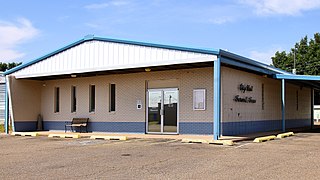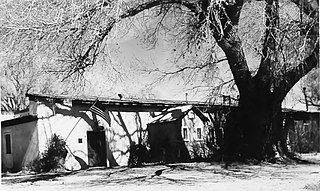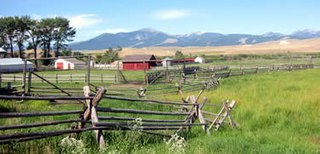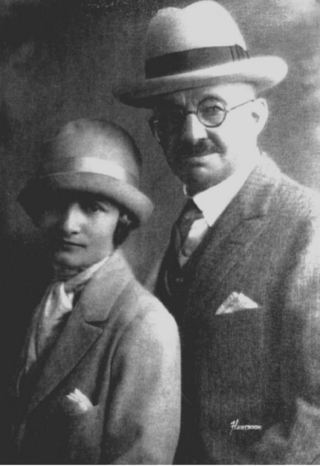
The Texas Longhorn is an American breed of beef cattle, characterized by its long horns, which can span more than 8 ft (2.4 m) from tip to tip. It derives from cattle brought from the Iberian Peninsula to the Americas by Spanish conquistadores from the time of the Second Voyage of Christopher Columbus until about 1512. For hundreds of years the cattle lived a semi-feral existence on the rangelands; they have a higher tolerance of heat and drought than most European breeds. It can be of any color or mix of colors. In some 40% of the cattle it is some shade of red, often a light red; the only shade of red not seen is the deep color typical of the Hereford.

Farwell is a city in and the county seat of Parmer County, Texas, United States. Its population was 1,363 at the 2010 census. The city is located on the Texas-New Mexico border with the city of Texico, New Mexico across the border.

King Ranch is the largest ranch in the United States. At some 825,000 acres it is larger than the state of Rhode Island and country of Luxembourg. It is mainly a cattle ranch, but also produced the Triple Crown winning racehorse Assault.
The Colorado Ranger is a horse breed from the Colorado High Plains in the United States. The breed is descended from two stallions imported from Turkey to the US state of Virginia in the late 1800s. These stallions were then bred to ranch horses in Nebraska and Colorado, and in the early 1900s the two stallions who every registered Colorado Ranger traces to, Patches #1 and Max #2, were foaled. The breed was championed by rancher Mike Ruby, who founded the Colorado Ranger Horse Association in 1935. Original registry membership limits resulted in many Colorado Ranger horses being registered instead as Appaloosas, but pedigree research is ongoing to discover additional horses who trace their ancestry back to the original stallions.

Cattle drives were a major economic activity in the 19th and early 20th century American West, particularly between 1850s and 1910s. In this period, 27 million cattle were driven from Texas to railheads in Kansas, for shipment to stockyards in Louisiana and points east. The long distances covered, the need for periodic rests by riders and animals, and the establishment of railheads led to the development of "cow towns" across the frontier.

The Bell Ranch is a historic ranch in Tucumcari, New Mexico, United States of America. Owned by John Malone since 2010, it is one of the largest privately owned ranches in the United States. As of 2021, Malone is the second largest land owner in the country with 2.2 million acres. The ranch became a national landmark in 1974.

A cutting horse is a stock horse, typically an American Quarter Horse, bred and trained for cutting, a modern equestrian competition requiring a horse and rider to separate a single cow from a herd of cattle and prevent it from getting back to the herd. One of the desired qualities in a cutting horse is "cow sense," described as an innate ability to read a cow, eye to eye, in anticipation of each move. The cutting horse has its roots in the historic cattle ranching industry, where horses with specialized cattle-handling skills were crucial for the work of the cowboy.

The Sierra Bonita Ranch, founded in 1872 by Henry C. Hooker, is one of the oldest cattle ranches in the United States and the ranch buildings have been designated a National Historic Landmark. It was the first permanent American cattle ranch in Arizona. Hooker bought neighboring ranches until his operation became the largest ranch in Arizona, totaling 800 square miles (2,100 km2), or about 30 by 27 miles. It is located in Sulphur Springs Valley about 27 miles (43 km) north of present-day Willcox, Arizona. The modern ranch is much smaller but is still operational and owned by Jesse Hooker Davis, the sixth generation to live and work on the ranch.

Don Adolfo Camarillo was a prominent Californio philanthropist, ranchero, and horse breeder, known for founding the city of Camarillo, California, along with his brother Juan Camarillo Jr. Camarillo also donated the land for Adolfo Camarillo High School. The horse breed Camarillo White Horse was named for Camarillo. He began breeding them in 1921 and the line continues today. Because of his philanthropy in 1950, Pope Pius XII named him a Knight of St. Gregory the Great.

Sheila Varian was an American breeder of Arabian horses who lived and worked at the Varian Arabians Ranch near Arroyo Grande, California. She grew up with a strong interest in horses, and was mentored in horsemanship by Mary "Sid" Spencer, a local rancher and Morgan horse breeder who also introduced Varian to the vaquero or "Californio" tradition of western riding. She started her horse ranch, Varian Arabians, in 1954 with the assistance of her parents. Raising and training horses was her full-time occupation beginning in 1963. She used vaquero-influenced methods of training horses, although she adapted her technique over the years to fit the character of the Arabian horse, which she viewed as a horse breed requiring a smart yet gentle approach.

A ranch is an area of land, including various structures, given primarily to ranching, the practice of raising grazing livestock such as cattle and sheep. It is a subtype of a farm. These terms are most often applied to livestock-raising operations in Mexico, the Western United States and Western Canada, though there are ranches in other areas. People who own or operate a ranch are called ranchers, cattlemen, or stockgrowers. Ranching is also a method used to raise less common livestock such as horses, elk, American bison, ostrich, emu, and alpaca.

Aztec Land and Cattle Company, Limited ("Aztec") is a land company with a historic presence in Arizona. It was formed in 1884 and incorporated in early 1885 as a cattle ranching operation that purchased 1,000,000 acres in northern Arizona from the Atlantic & Pacific Railroad. It then imported approximately 32,000 head of cattle from Texas and commenced ranching operations in Arizona. Because Aztec's brand was the Hashknife, a saddler's knife used on early day ranches, the company was known more famously as The Hashknife Outfit. The company has been in continuous existence since 1884.

Montoya is an unincorporated community on the route of historic Route 66 in Quay County, New Mexico, United States. It is the site of the Richardson Store, which listed on the National Register of Historic Places.
Christopher Columbus Slaughter (1837–1919) was an American rancher, cattle drover and breeder, banker and philanthropist in the Old West. After serving in the Confederate States Army during the American Civil War of 1861–1865, he came to own 40,000 cattle and over one million acres of ranch land in West Texas. He became the largest taxpayer in Texas, and used his wealth to endow Baptist institutions. He was known as the "Cattle King of Texas."
Henry B. Sanborn was an American businessman, rancher, hotelier, horse breeder and philanthropist. He was known as the "Father of Amarillo, Texas."
Mayer Halff (1836–1905) was a pioneering rancher in Texas and a prominent member of the Jewish community of that state. Mayer acquired 1,000,000 acres (400,000 ha) of ranchland in western Texas and New Mexico and at one time was the third largest cattle owner in the United States.

Eternal Sun (1958–1985) was an American Quarter Horse foaled in 1958. He was a Quarter Horse race horse and an American Quarter Horse Association (AQHA) show horse who competed in cutting and halter classes. He earned numerous AQHA awards throughout his career, including an AQHA Championship. He was also a sire of 908 foals, many of whom are themselves AQHA award earners and race horses. He was inducted into the Michigan Quarter Horse Association Hall of Fame in 1989, later followed by his daughter, Eternal Linda. He died at the age of 27 in 1985 on Harold Howard's farm.
Fay Owen "Buster" Welch was an American cutting horse trainer and inductee into the NCHA Members Hall of Fame, American Quarter Horse Hall of Fame, National Cutting Horse Association Riders Hall of Fame and Texas Cowboy Hall of Fame. Buster was chosen as the recipient of the 2012 National Golden Spur Award for his "outstanding contributions to the ranching and livestock industry".

Yetta Kohn was a German-American immigrant who came to New Mexico and became a businesswoman, rancher, and ferry operator. After her husband died in 1877, Kohn operated the family's wool and hide business. She became a real estate investor and a cattle rancher. The T4 Cattle Company ranch, which has remained a family business, in Montoya, New Mexico has become one of the largest private ranches in the United States. Besides mercantile stores, Kohn has also operated banks, a ferry, and a post office.

Howard Louis Kohn and Clara (McGowan) Kohn were New Mexican businesspeople and ranchers of T4 Cattle Company, one of the largest private ranches in the United States with about 220,000 acres. They also held a hotel, banks, and mercantile shop. Howard shipped cattle on railroad cars from Texas into New Mexico in groups as large as 1,200 at a time.














